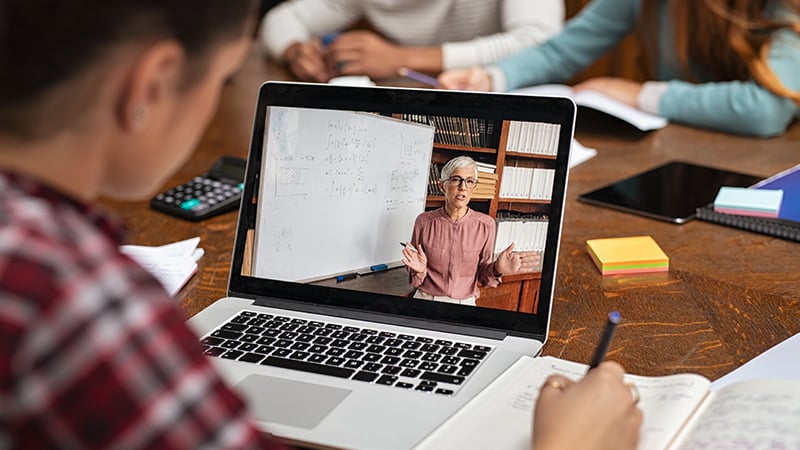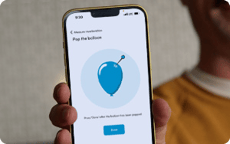HyFlex learning – a new fixture in higher education

Posted by Nancy Knowlton | President and CEO of Nureva Inc. on Jun 23, 2021 6:00:00 AM
Many people are so ready for the pandemic to be over. And after the past 18 months, who can blame them?
Those in higher education may talk wistfully about going back to normal – the old normal that they knew and now nostalgically recall that they loved. That normal had everyone on campus and in the classroom.
But did they really love that old normal? Or are they just yearning for more human contact and to be done with the pandemic that upended life in so many ways for so many? Are there advantages to be gained from being more flexible? Can a combination of in-classroom and out-of-classroom learning offer something that a singular approach cannot?
While there undoubtedly will be a rush back to campus and the traditional postsecondary classroom, some changes that happened during the pandemic don’t need to be fully reversed.
I think HyFlex and other hybrid approaches to higher education are here to stay – and have the potential to transform the student experience in very positive ways. Here’s why.

Many students prefer it
While some may have thought that students were passive consumers of higher education, that pigeon-holing is over. Students have learned what is possible, and they want a greater say in how they consume education. Mom and dad may still help determine their choice of university or college, but students are demanding more control over the product that they receive and how they consume it.
Though COVID-19 has been a struggle in real ways, many students found silver linings in a more flexible approach to education. A recent survey found that 68% of postsecondary students are now interested in taking courses that offer a combination of in-person and online instruction, while 73% see value in some courses being offered fully online. As the more isolating effects of COVID dissipate, more and more students are likely to look for flexibility in their college experience.

Instructors developed new skills
When universities and colleges abruptly sent students home in spring 2020, the learning curve for instructors couldn’t have been steeper. But over the last year, they developed a wide range of skills in delivering courses that were fully or partially online. And now that the pandemic-related chaos has settled, instructors can further develop HyFlex courses that deliver an exceptional experience.
Of course, many postsecondary institutions were already experimenting with hybrid learning models before 2020. Though COVID-19 certainly accelerated things, the shift away from purely traditional forms of in-class instruction has been a long time coming.
As our world starts to open up, more flexibility in postsecondary education can benefit instructors too. Professors can more easily attend conferences or travel for research – all while still having the tools to give students an uninterrupted learning experience. This has been the case for Gary Kayye of UNC, who even before COVID designed a classroom that enabled him to teach from anywhere.

Flexible work is the future
Just as hybrid learning is growing in higher education, many organizations are shifting to hybrid work to give employees the flexibility they now desire. In a recent survey by Slack, 63% of employees favored a hybrid remote-office model, with only 17% looking to return to full-time office work. It’s likely that arrangements that include some days in the office and some at home will become the norm for many knowledge workers.
As hybrid work becomes increasingly common, employers will need to hire people who can do their jobs effectively in person and remotely. Job seekers need to demonstrate that they can collaborate and communicate in hybrid meetings and through asynchronous tools. So colleges and universities that give students these options are helping prepare many of them for this reality.

International students need it
For many institutions, international students are a key demographic to attract – because of the out-sized tuition they pay and the diversity they contribute to the campus. But COVID-19 has been particularly turbulent for many of these students, with students reporting the challenges of global travel restrictions, loss of campus housing and more.
Blending different learning options now – in-classroom, at home, in the dorm room – can ensure that any future needs to move online are less traumatic and disruptive. For students who may need to juggle in-person attendance with challenges that force them to return home for a period of time, the flexibility of HyFlex will make this possible.
And international students are not the only demographic that need an extra degree of flexibility. Adult students, part-time students and those with additional learning needs also need approaches that give them options – whether facing extraordinary challenges like the pandemic or not.

Postsecondary institutions need to be ready
When I talk to postsecondary IT directors the world over, I hear the same thing – they have been tasked with “being ready” by their administrations. If a new situation arises that demands the same kind of pivot that COVID did, we need to have the right processes and edtech tools in place to respond.
That’s where I think HyFlex comes in. If learning spaces are already equipped to allow for remote learning, they’ll be ready for the next crisis that comes our way. And if students already have the skills to learn outside the classroom, they can make a smooth shift to a different kind of course delivery should the need arise.
HyFlex is here to stay
This doesn’t mean that I think everyone going fully online is the answer. After all, the postsecondary experience is about more than simply attending class and cramming a student’s head with knowledge.
It’s also about having them grow and develop as human beings – developing friendships, taking risks, achieving success, learning to cope with disappointment and failure and getting ready for a grown-up world. Much of that growing-up process is best experienced face to face, so campus life will remain an integral part of the postsecondary experience.
But just as I’m looking forward to students once again filling campuses with laughter and conversation, I also hope that students will gain more flexibility in how they learn. That’s why I think HyFlex is here to stay.

Posted by
Nancy Knowlton | President and CEO of Nureva Inc.
June 23, 2021

















